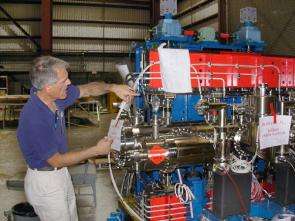Beamline 12 to Unlock Secrets of Organic Molecules

Starting this fall, scientists will have a new tool for peering into the materials that make up living systems at the Molecular Observatory for Structural Molecular Biology at the Stanford Synchrotron Radiation Laboratory (SSRL), thanks to a collaboration between CalTech and SLAC.
Just as astronomers study distant stars and galaxies, molecular biologists deal with materials that seem as inaccessible as the far reaches of the cosmos. And, as astronomers use specialized observatories, chemists and biologists need advanced tools for imaging nano-scale molecular structures.
Beginning in 2007, researchers at SSRL will have a brand new protein crystallography experimental station at Beamline 12 to help unlock the secrets of organic molecules on the atomic level. Using robotic remote-access systems similar to ones already in use at SSRL, the new beamline will offer a state-of-the art observatory for mapping out the shapes and mechanics of the molecular structures that make life possible.
"This will be a tremendous resource for SSRL and for CalTech," said beamline development group leader Tom Rabedeau.
The key to this new observatory will be an "in vacuum undulator"—the first of its kind at SLAC—to be installed onto the SPEAR3 storage ring during the fall shutdown. Undulators are devices that deflect the passing electron beam back and forth between rows of alternating magnets, making it "undulate" and thereby give off powerful x-rays. The device itself consists of upper and lower plates or "jaws" that contain the rows of magnets that operate from the outside of the vacuum pipe. The opening between these jaws can be adjusted to control the properties of the x-rays emitted, but the jaws of a typical device of this sort can be closed together only so far as the thickness of the vacuum pipe. However, because the magnets of the new undulator sit inside a vacuum chamber attached to the storage ring, the magnets can be brought very close together, creating a much stronger effect on the electron beam and giving researchers tighter control of the x-rays produced.
Protein crystallography relies on these tightly controlled, highly focused x-ray beams to probe the molecular structure of different materials. This is done by blasting a crystallized sample with x-rays and analyzing the pattern of the scattered beam.
The Beamline 12 upgrades will give the Molecular Observatory a degree of precision that promises to push the boundaries of atomic and molecular scale imaging. Knowing the blueprint of proteins and nucleic acids (DNA and RNA), so-called "macromolecules," will help address such fundamental questions as how the chemistry life is achieved and regulated within cells.
SLAC and CalTech will divide the research time on the new beamline, now under construction during SSRL's annual shutdown. Development and installation of Beamline 12 was funded by the Gordon and Betty Moore Foundation through an agreement between the California Institute of Technology and Stanford University, SLAC and SSRL.
Source: by Brad Plummer, SLAC Today, Stanford Synchrotron Radiation Laboratory




















